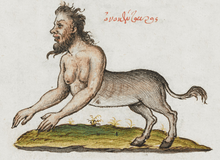Onocentaur
The onocentaur (Latin: onocentaurus, from Greek: Ὀνοκένταυρος, translit. Onokéntauros, lit. "donkey centaur") is an animal from Medieval bestiaries.

Description
The onocentaur is similar to the centaur, but part human, part donkey. As with many liminal beings, the onocentaur's nature is one of conflict between its human and animal components.[1]
The first mention by Pythagoras was in the time of rule of Ptolemy II Philadelphus, as quoted by Claudius Aelianus in De Natura Animalium. Aelian as well uses the term onokentaura for description of the female form.[2] He interpreted the onocentaur as: "its body resembles that of an ass, its colour is ashen but inclines to white beneath the flanks. It has a human chest with teats and a human face surrounded by thick hair. It may use its arms to seize and hold things but also to run. It has a violent temper and does not endure capture."[3]
The Septuagint translation of the book of Isaiah mentions onocentaurs twice, in verses 13:22[4]: "and onocentaurs will settle there and hedgehogs will make nests in their homes. It comes quickly and does not delay," and 34:14[5]: "and the spirits will meet with the onocentaurs and howl one to another, and the onocentaurs will stop because they have found rest." The corresponding words in the Hebrew are אִי "island-beast, howler, jackal" and שָׂעִיר, "hairy, he-goat, satyr."[6][7] Jerome's translation of the Septuagint and Vetus Latina versions into the Late Latin standard version, the Vulgate, preserved this interpretation.[8] John Wycliffe's early English-language translation of the Bible did not use the word "onocentaur", but instead glossed the term as: "wondurful beestis, lijk men in the hiyere part and lijk assis in the nethir part".[9] The later King James Version translates the word as "satyr".[10]
See also
References
- "Onocentaur". The Medieval Bestiary. Retrieved 2008-12-28.
- P. G. P. Meyboom (1994). "The Onokentaura". The Nile Mosaic of Palestrina: Early Evidence of Egyptian Religion in Italy. Leiden; New York: Brill. pp. 111–114. ISBN 90-04-10137-3.
- "Aelian, NA 17.9". English translation by A.F.Scholfield. Retrieved 2019-03-04.
- "Isaiah 13:22 (LXX)". Blue Letter Bible. Retrieved 2018-08-15.
- "Isaiah 34:14 (LXX)". Blue Letter Bible. Retrieved 2018-08-15.
- "Isaiah 13:22 (WLC)". Blue Letter Bible. Retrieved 2018-08-15.
- "Isaiah 34:14 (WLC)". Blue Letter Bible. Retrieved 2018-08-15.
- "Isaiah 34:14 et occurrent daemonia onocentauris et pilosus clamabit alter ad alterum ibi cubavit lamia et invenit sibi requiem". studybible.info. Retrieved 2020-01-18.
- "Isaiah 34:14 And fendis, and wondurful beestis, lijk men in the hiyere part and lijk assis in the nethir part, and an heeri schulen meete; oon schal crie to an other". studybible.info. Retrieved 2020-01-18.
- "Isaiah 34:14 The wild beasts of the desert shall also meet with the wild beasts of the island, and the satyr shall cry to his fellow; the screech owl also shall rest there, and find for herself a place of rest". studybible.info. Retrieved 2020-01-18.
External links
| Look up onocentaur in Wiktionary, the free dictionary. |
![]()
.jpg)